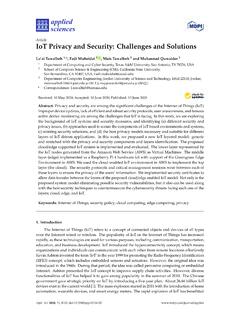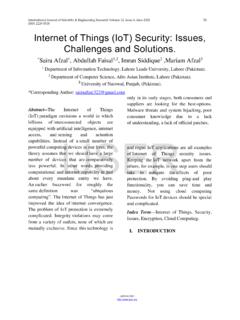Transcription of Industry 4.0 Challenges and solutions for the digital ...
1 Audit. Tax. Consulting. Corporate and solutions for the digital transformation and use of exponential technologiesContentsAbout the studyThis study sets out the key Challenges Switzerland s manufacturing companies face in achieving the digital transformation of the Industry and benefitting from exponential focuses on the Swiss mechanical and electrical engineering, and metalworking industries, and the chemical and construction March and August 2014, more than 50 manufacturing companies operating in Switzerland completed questionnaires and took part in personal companies taking part included among others ABB, agta record, Alstom, Autoneum, B hler, Burkhalter.
2 Burckhardt Compression, Cicor, Eaton, Faulhaber Minimotor, Fisba Optik, GF Machining solutions , Gurit, Hilti, IHI Ionbond, Jungheinrich, Kaba, Meyer Burger, Mikron, Rapid, Reichle & De-Massari, Rieter, Siemens, Sonova, Trisa and Walter and Executive summary 1 What is Industry 3 Definition and development 3 Main characteristics 6 Where is Switzerland in the Industry process? 9 Competitiveness 9 Opportunities and risks 11 The question of resources 13 Potential for individual business segments 15 Impetus from exponential technologies 17 Industry solutions 22 Vertical networking 22 Horizontal integration 23 Through-engineering 24 Exponential technologies 25 Endnotes 26 Contacts
3 27 Introduction and Executive summaryDear readerAround the world, traditional manufacturing Industry is in the throes of a digital transformation that is accelerated by exponentially growing technologies ( intelligent robots, autonomous drones, sensors, 3D printing). The pace of change reflects Moore s law on the speed at which information technology-driven change happens. Companies and their industrial processes need to adapt to this rapid change if they are not to be left behind by developments in their sector and by their trends are not to be compared simply with a greater level of production automation, a process that has, since the 1970s, been driven by developments in electronics and information technology.
4 The widespread adoption by manufacturing Industry around the world of information and communications technology is now paving the way for disruptive approaches to development, production and the entire logistics chain. This networking within an internet of things, services, data and people will transform the future of manufacturing. Commentators use the term Industry to refer to a fourth industrial revolution with four main characteristics:1. The vertical networking of smart production systems, such as smart factories and smart products, and the networking of smart logistics, production and marketing and smart services, with a strong needs-oriented, individualised and customer-specific production operation2.
5 Horizontal integration by means of a new generation of global value-creation networks, including integration of business partners and customers, and new business and cooperation models across countries and continents3. Through-engineering throughout the entire value chain, taking in not only the production process but also the end product that is, the entire product life cycle4. Acceleration through exponential technologies that, while not really new in terms of their development history, are only now capable of mass-market application as their cost and size have come down ( sensor technology) and their computing power has risen study investigates the extent to which Swiss manufacturing companies have already positioned themselves in relation to this digital transformation and the opportunities the switch to Industry offers them.
6 Increase competitiveness: a clear majority of companies surveyed believe that the digital transformation to Industry will increase their competitiveness. Only a small minority of companies see this transformation affecting their current business, although they believe that major change is inevitable. A few individual companies argue that Industry could slow down the trend towards relocating production to low-wage countries, but this argument overlooks the fact that, as a result of automation, the trend towards relocation is often driven more by the need to produce goods locally in new growth markets than by the ability to produce goods more cheaply. Our last report (Innovation reinvented, published in September 2013) clearly demonstrated the vital importance of innovation for the Swiss manufacturing Industry and its competitiveness.
7 The digital transformation to Industry will have an impact right across both local and global value chains in low-cost as well as high-cost countries. Utilise opportunities and reduce risks: Industry represents a number of major opportunities for Swiss manufacturing. It will open up new ways for companies to integrate their customers needs and preferences into their development and production processes, including via direct data-sharing with their machinery. It will also make it easier to analyse machine data, helping to enhance quality and avoid faults in the production process. In terms of risks, companies believe that the digital transformation to Industry could further increase the already heightened cyber risk to manufacturing Industry .
8 Leading manufacturing companies are taking a proactive approach to both opportunities and Challenges and solutions for the digital transformation and use of exponential technologies1 Adjust talent and IT resources: most of the companies surveyed note that in many areas, they do not have all the staff they need to make the digital transformation to Industry One-third of companies have an appropriate IT infrastructure in place for the switch to Industry , but just under half believe that their infrastructure is not wholly suitable. The remaining companies report that they lack the appropriate infrastructure for change on this scale. If the digital transformation to Industry is to be successful, however, it is essential that businesses invest in appropriate skills and an excellent IT infrastructure.
9 Develop potential for individual business segments: research and development (R&D), procurement and purchasing, production, and warehousing and logistics are currently at the heart of the digital transformation to Industry , while sales and services are the segments with the greatest potential to benefit from it. In these segments, more strongly individualised solutions have the capacity to take manufacturing into a whole new era of customisation. This will require the sector to switch from the push into the market of better products for their customers to an individualised understanding of customers needs and specialised, Industry -specific solutions ( pull from the customer ).
10 Use impetus from exponential technologies: a majority of companies surveyed agree that the key technology 3D printing (additive manufacturing) will accelerate the transformation of the Swiss manufacturing Industry to Industry According to our survey findings, only very few manufacturing companies are so far making full use of the scope offered by 3D printing technology in their development, production and logistics processes. Just one-halve of those surveyed plan to invest in 3D printing technology in future. Most companies are only just beginning to use this new technology and there is a risk that they may miss the opportunity, because some companies have already been working with 3D printing for several years and are developing the next generation of applications.
















